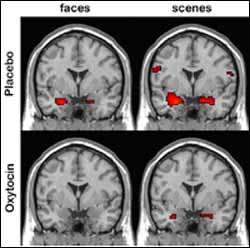Trust-building hormone short-circuits fear in humans

Functional magnetic resonance imaging data (red) superimposed on structural MRI scans. Frightful faces triggered a dramatic reduction in amygdala activity in subjects who had sniffed oxytocin, suggesting that oxytocin mediates social fear and trust via the amygdala and related circuitry. Source: NIMH Genes, Cognition and Psychosis Program.
A brain chemical recently found to boost trust appears to work by reducing activity and weakening connections in fear-processing circuitry, a brain imaging study at the National Institutes of Health’s (NIH) National Institute of Mental Health (NIMH) has discovered. Scans of the hormone oxytocin’s effect on human brain function reveal that it quells the brain’s fear hub, the amygdala, and its brainstem relay stations in response to fearful stimuli. The work at NIMH and a collaborating site in Germany suggests new approaches to treating diseases thought to involve amygdala dysfunction and social fear, such as social phobia, autism, and possibly schizophrenia, report Andreas Meyer-Lindenberg, M.D., Ph.D., NIMH Genes Cognition and Psychosis Program, and colleagues, in the December 7, 2005 issue of the Journal of Neuroscience.
“Studies in animals, pioneered by now NIMH director Dr. Thomas Insel, have shown that oxytocin plays a key role in complex emotional and social behaviors, such as attachment, social recognition and aggression,” noted NIH Director Elias Zerhouni, M.D.. “Now, for the first time, we can literally see these same mechanisms at work in the human brain.”
“The observed changes in the amygdala are exciting as they suggest that a long-acting analogue of oxytocin could have therapeutic value in disorders characterized by social avoidance,” added Insel.
Inspired by Swiss scientists who last summer reported [1] that oxytocin increased trust in humans, Meyer-Lindenberg and colleagues quickly mounted a brain imaging study that would explore how this works at the level of brain circuitry. British researchers had earlier linked increased amygdala activity to decreased trustworthiness. [2] Having just discovered decreased amygdala activity in response to social stimuli in people with a rare genetic brain disorder that rendered them overly trusting of others, Meyer-Lindenberg hypothesized that oxytocin boosts trust by suppressing the amygdala and its fear-processing networks.
To test this idea, he asked 15 healthy men to sniff oxytocin or a placebo prior to undergoing a functional magnetic resonance imaging (fMRI) scan, which reveals what parts of the brain that are activated by particular activities. While in the scanner, the men performed tasks known to activate the amygdala – matching angry or fearful faces and threatening scenes.
As expected, the threatening pictures triggered strong activation of the amygdala during the placebo scan, but markedly less activity following oxytocin. The difference was especially pronounced in response to threatening faces, suggesting a pivotal role for oxytocin in regulating social fear. In addition, oxytocin dampened the amygdala’s communication with sites in the upper brainstem that telegraph the fear response. The results mirrored findings in rats [3], reported earlier this year by European scientists.
“Because increased amygdala activation has been associated with social fear in social phobia, genetic risk for anxiety and depression, and possibly with social fear in autism assessed during faces processing, this dual mode of action of oxytocin in humans suggests a potentially powerful treatment approach toward socially relevant fear,” suggest the researchers.
People with autism characteristically avert their gaze from faces. A fMRI study [4] reported earlier this year by NIMH grantee Richard Davidson, Ph.D., University of Wisconsin, and colleagues, found over-activation of the amygdala in people with autism when they were looking at faces. Meyer-Lindenberg said future studies may test oxytocin as a treatment for such social anxiety symptoms in children with autism.
“Future research may also examine how oxytocin affects the amygdala in women, the mode of action of related hormones such as vasopressin, and how genetic variants in these hormones and their receptors affect brain function,” he added.
Also participating in the research were: Peter Kirsch, Christin Esslinger, Daniela Mier, Stefanie Lis, Harald Gruppe, Bernd Gallhofer, Justus-Liebig University, Giessen, Germany; Qiang Chen, Sarina Siddhanti, Venkata Mattay, NIMH Genes Cognition and Psychosis Program.
Media Contact
More Information:
http://www.nih.govAll latest news from the category: Health and Medicine
This subject area encompasses research and studies in the field of human medicine.
Among the wide-ranging list of topics covered here are anesthesiology, anatomy, surgery, human genetics, hygiene and environmental medicine, internal medicine, neurology, pharmacology, physiology, urology and dental medicine.
Newest articles

Webb captures top of iconic horsehead nebula in unprecedented detail
NASA’s James Webb Space Telescope has captured the sharpest infrared images to date of a zoomed-in portion of one of the most distinctive objects in our skies, the Horsehead Nebula….

Cost-effective, high-capacity, and cyclable lithium-ion battery cathodes
Charge-recharge cycling of lithium-superrich iron oxide, a cost-effective and high-capacity cathode for new-generation lithium-ion batteries, can be greatly improved by doping with readily available mineral elements. The energy capacity and…

Novel genetic plant regeneration approach
…without the application of phytohormones. Researchers develop a novel plant regeneration approach by modulating the expression of genes that control plant cell differentiation. For ages now, plants have been the…





















